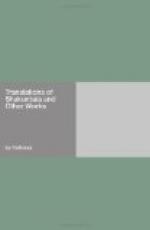On the other hand, we are met by the fact that numerous commentators, living in different parts of India, know the text of only nineteen cantos. Furthermore, it is unlikely that Kalidasa left the poem incomplete at his death; for it was, without serious question, one of his earlier works. Apart from evidences of style, there is the subject-matter of the introductory stanzas, in which the poet presents himself as an aspirant for literary fame. No writer of established reputation would be likely to say:
The fool who seeks a poet’s fame,
Must look for ridicule and blame,
Like tiptoe dwarf who fain would try
To pluck the fruit for giants high.
In only one other of his writings, in the drama which was undoubtedly written earlier than the other two dramas, does the poet thus present his feeling of diffidence to his auditors.
It is of course possible that Kalidasa wrote the first nineteen cantos when a young man, intending to add more, then turned to other matters, and never afterwards cared to take up the rather thankless task of ending a youthful work.
The question does not admit of final solution. Yet whoever reads and re-reads The Dynasty of Raghu, and the other works of its author, finds the conviction growing ever stronger that our poem in nineteen cantos is mutilated. We are thus enabled to clear the author of the charge of a lame and impotent conclusion.
Another adverse criticism cannot so readily be disposed of; that of a lack of unity in the plot. As the poem treats of a kingly dynasty, we frequently meet the cry: The king is dead. Long live the king! The story of Rama himself occupies only six cantos; he is not born until the tenth canto, he is in heaven after the fifteenth. There are in truth six heroes, each of whom has to die to make




